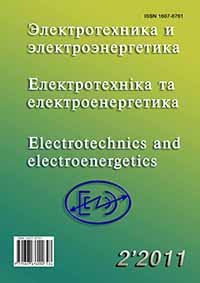RELIABILITY OF MICROPROCESSOR-BASED PROTECTIVE DEVICES – REVISITED
DOI:
https://doi.org/10.15588/1607-6761-2011-2-8Keywords:
microprocessor-based, protective devices, reliability, relay protection, life expectancy, intensity of failures, failure rateAbstract
The article is a continuation of a set of the author’s previous publications about the reliability of the microprocessorbased protective devices. The statistical data introduced by the author, coincide with data of other authors and confirm higher reliability of electromechanical relays in comparison with microprocessor-based. The inadequacy of the criterion for estimating the reliability of the protective relay is noted and a new normalized criterion for such estimation is offered by authorReferences
Gurevich, V. Microprocessor Protection Relays: New Prospects or New Problems? / V. Gurevich // Electr. Engineering and Electromechanics.– 2006. – No 3. –Р. 18–26.
Gurevich, V. I. Microprocessor Protective Relays: Alternative View / Gurevich V. I. // «Energo-Info». –2006. – No 4 (30). –Р. 40–46.
Gurevich, V. I. How to Equip a Relay Protection: Opinions of Russian Experts and a View from Outside / V. I. Gurevich // Electric Power’s News. – 2007. –No 2. – Р. 52–59.
Gurevich, V. Reliability of Microprocessor-Based Relay Protection Devices – Myths and Reality / V. Gurevich // Serbian Journal of Electr. Engineering. –2009. – No 1 (vol. 6).
Gurevich, V. I. Answer from author of the article: «Reliability of Microprocessor-Based Relay Protection Devices – Myths and Reality» on ctitical eview by O. Zacharov, Published on the Web Portal «All about relay protection» (http://www.rza.org.ua/article/a-64.html).
Gurevich, V. Hybrid Reed-Solid-State Devices are a New Generation of Protective Relays, / V. Gurevich // Serbian Journal of Electr. Engineering. – 2007.– No 1(vol. 4) – Р. 85–94.
Konovalova, E. V. Main results of relay protection devices maintains in power systems in the Russian Federation / E. V. Konovalova // Relay protection and automatics of power systems : Collection of reports of XV scientific and technical conference. – Moscow, 2002 (Rus.).
General technical requirements on microprocessor based protective devices and automatics for power systems – РД 34.35.310-97, Moscow, 1997.
The review on article by O. Zaharov «The combined power supplies. Characteristics of output circuits» / O. Zaharov // Published in the magazine «Electric Power’s News». – 2009. – No 2.
Heising, C. R. Digital Relay Software Quality / C. R. Heising, R. C. Patterson, E. Y. Weintraub // General Electric, GER-3660.
Heising, C. R. Reliability Expectations for Protective Relays. Developments in Power Protection / C. R. Heising, R. C. Patterson // Fourth International Conference in Power Protection, 11–13 Apr., 1989, Edinburgh, UK.
Shalin, A. I. About efficiency of new relay protection devices / A.I. Shalin // Power and industry of Russia (the selected publications), vol. 203.
Shneerson, E. M. Operational efficiency of relay protection devices: a reality and abilities / E. M. Shneerson // Energoexpert. – 2007. – No 4–5. – Р. 70–77.
Kudryashov V. N. Experience with using a microprocessor based protection in Mosenergo / V. N. Kudryashov, V.V. Balashov, A. G. Korolyov, A. V. Sdobin // Relay protection and automatics of power systems : Collection of reports of XV scientific and technical conference. – Moscow, 2002.
Ward, S. Improving Reliability for Power System Protection / Ward, T. Dahlin, W. Higinbotham // 58th Annual Protective Relay Conference, Atlanta, GA, April 28–30, 2004. 16. Shneerson, E. M. Digital relay protection / E. M. Shneerson. – Energoatomizdat, 2007. – 548 p.
Downloads
How to Cite
Issue
Section
License
Copyright (c) 2017 V. I. Gurevich

This work is licensed under a Creative Commons Attribution 4.0 International License.
Creative Commons Licensing Notifications in the Copyright Notices
Authors who publish with this journal agree to the following terms:
Authors retain copyright and grant the journal right of first publication with the work simultaneously licensed under aCreative Commons Attribution License that allows others to share the work with an acknowledgement of the work's authorship and initial publication in this journal.
Authors are able to enter into separate, additional contractual arrangements for the non-exclusive distribution of the journal's published version of the work (e.g., post it to an institutional repository or publish it in a book), with an acknowledgement of its initial publication in this journal.
Authors are permitted and encouraged to post their work online (e.g., in institutional repositories or on their website) prior to and during the submission process, as it can lead to productive exchanges, as well as earlier and greater citation of published work.

